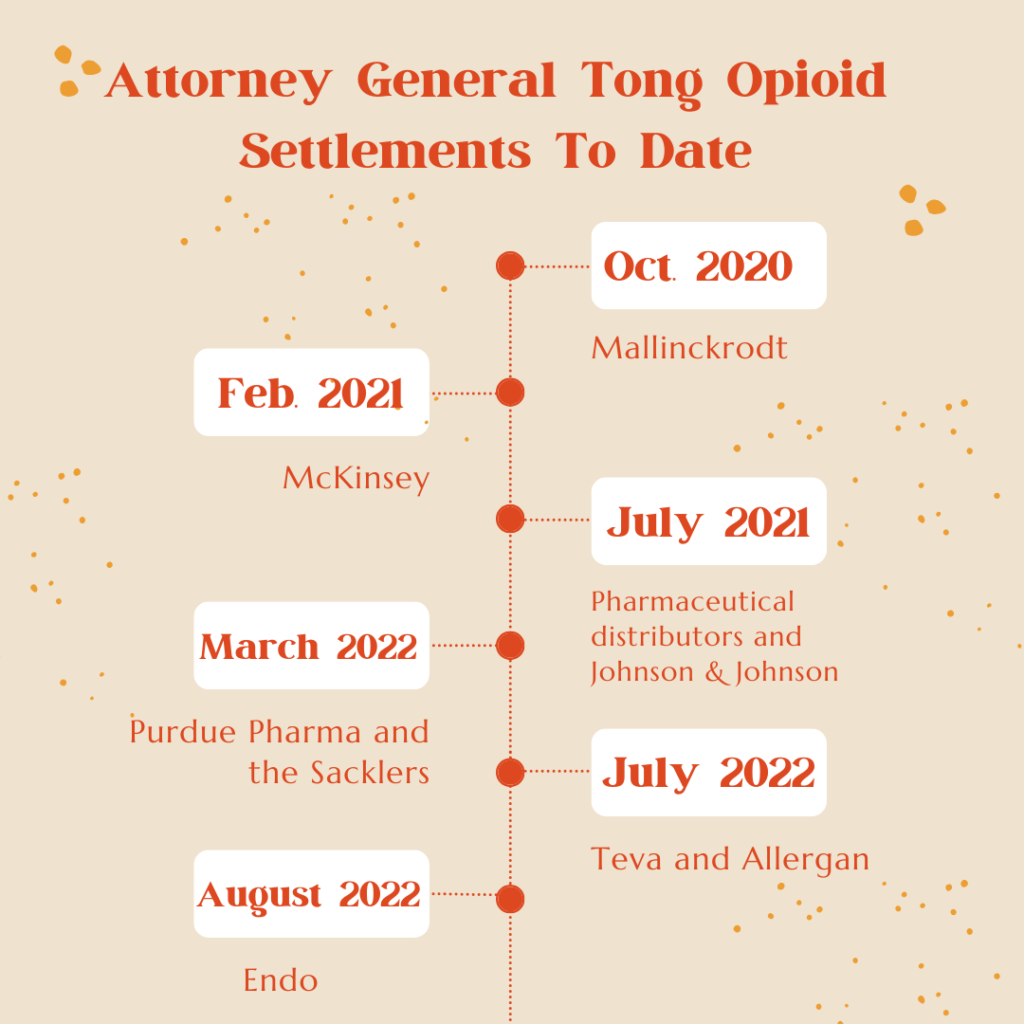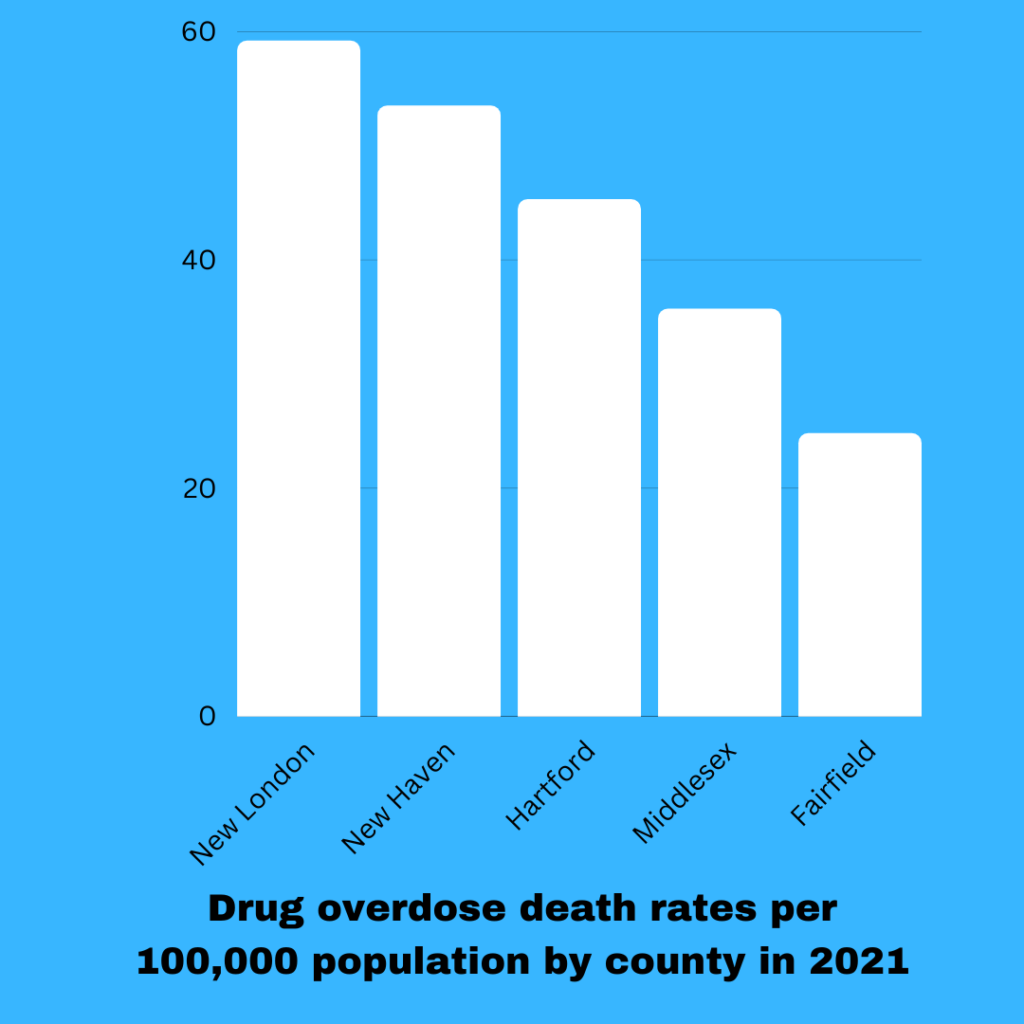Opioid settlements could bring an estimated $600 million over the next decade to Connecticut. Large companies such as manufacturer Purdue Pharmaceuticals LP., chains CVS Health, Walgreen Co. and Walmart Inc., and elite management consultants McKinsey & Co. each owe the state millions of dollars.
In August, the Supreme Court temporarily blocked the bankruptcy deal for Purdue Pharma that shielded members of the Sackler family from additional civil lawsuits.
Purdue Pharma began selling the drug Oxycontin when the the Food and Drug Administration approved it in 1996. The Stamford-based company misled consumers, minimizing the risk of addiction and claiming it was safer than other drugs. McKinsey worked with the company to boost oxycontin sales.
Attorney General William Tong has led many of the opioid settlements. He announced in March 2022 that Purdue Pharma and the Sackler family will have to pay $6 billion to victims, survivors and states.

Information from Ct.gov
According to the Centers for Disease Control and Prevention, Connecticut had 1,418 deaths from opioid overdoses in 2021.
The Connecticut Opioid Settlement Advisory Committee has a legislative mandate to ensure the appropriate allocation of the funds.
“There’s services, support for prevention, treatment and recovery services, and it’s done so transparently and with accountability,” said Art Mongillo, the director of communications for the Connecticut State Department of Mental Health and Addiction Services.
A Sept. 13 report from the Yale Schools of Medicine and Public Health recommended using the settlement to expand access to methadone and buprenorphine treatment, to fund harm reduction centers, to combine overdose prevention data on one platform, and to expand the addiction specialist workforce.
In 2021, New Haven County had a drug overdose rate of 53.5 per 100,000 population, behind New London County which was 59.2. In Hartford the rate was 45.3, in Middlesex 35.7 and Fairfield 24.8.

Source: Connecticut Department of Public Health
“Where we’re being affected in terms of the numbers of overdoses it’s in the large municipalities, where there’s a larger cluster of people.” Mongillo said.
Cities including Bridgeport, Waterbury and New Haven have the most opioid overdoses.
“You can’t arrest your way out of an opioid overdose epidemic,” said Stephen Holt, an associate professor of medicine at Yale, who directs the Yale Addiction Recovery Clinic located in New Haven.
Holt said how he thinks if the opioid settlement money goes to the right people, it will have a positive outcome for people with addiction. He suggested that the opioid settlement money go toward peer recovery coaches, medications for substance-use disorders, housing, and smartphone apps for those in recovery.
Holt sees patients two days per week at the clinic for a variety of substance disorders. He said an estimated time patients stay at the clinic depends on the person and how far along they are in recovery, like one patient may have a visit for an hour and then another hour if they choose to do group therapy.
Some Yale medical students do clinical rotations at the recovery clinic.
“It’s intended to educate primary care residents to learn about how to treat addiction going forward, so by design we are a smaller practice,” Holt said.
Currently, there are around 100 patients in opioid addiction recovery that are registered at the clinic. There are also some behavioral health services, 12-step yoga sessions, as well as a clinical psychologist on staff.
“I love treating all kinds of patients,” Holt said. “I have just found that fulfillment that I get from helping folks with addiction and seeing their true selves emerge from the intoxication and withdrawal and just misery that can come with addiction.”
John Lally has worked with substance abuse for over 39 years. His son died of a heroin overdose at the age of 29.
“Obviously losing my oldest child, not something I’ll ever get past,” said Lally of Ellington. “This is my mission to make something positive come from his struggle, to give his life some greater meaning.”
The Connecticut State Department of Mental Health and Addiction Services is planning to open a website on Oct. 16, where the public or professionals can submit proposals on how the opioid settlement money should be spent, Lally said. He wants the money for harm reduction, such as clean needles, test strips, expanding treatment centers, and education about mental health and drugs in school.
“I’m there representing the interests of families who have been through the struggle,” said Lally, who has another son who’s been in recovery for five years. “We’re hoping then to advise the state on how to best spend the money to help people who are struggling or help prevent people from struggling.”
Although the money won’t solve substance abuse, it can bring more resources “to make a dent in it, to save lives very soon and help people who are struggling,” Lally said.
He blames pharmaceutical companies that mislead consumers, putting money over people’s lives and thinks those responsible should be in jail.
“They (pharmaceutical companies) looked away from the problem knowing that people were dying and knowing they could make a difference and they didn’t do that,” Lally said. “To me that’s criminal.”
Lally created a non-profit called Today I Matter, named for his late son Tim to honor his drive while in treatment and encourage others to seek help.
“Our message says, ‘No, you all matter today, ‘cause you matter every day,” Lally said. “The rest of us matter and that we can make a difference in someone else’s lives if we try.”
The non-profit does public outreach, works with politicians, and offers scholarships in Ellington for art and music, which Timothy loved. It is best known for collecting 635 posters with the names, photos and two words describing those who have passed. Lally hopes the posters can fight the stigma of addiction and make it easier to talk about.
“We want to make these people come alive,” Lally said. “Nowhere on our posters does it say ‘addict,’ because we want them to be remembered for so much more than one of the problems they dealt with.”
Christine Gagnon, is also a member of the Connecticut Opioid Settlement Advisory Committee from Southington and has previously worked for the Heroin Education Action Team of the U.S. Attorney’s Office. Her son Michael, died at 22 from a fentanyl overdose.
Gagnon expects the bankruptcy plan to be challenged in December, which will be deciding whether the bankruptcy code gives the court has the power to a release that gets rid of claims against third parties without the consent of the individuals or entities holding the claims. If the bankruptcy plan happens, the Sackler family would be released from third parties trying to sue.
Gagnon has worked with the Attorney General and said he is continuing to fight for Connecticut’s share of the proceeds. The Attorney General is in support of reforms to bankruptcy laws that would prohobit non-bankrupt individuals and businesses from exploiting loopholes in the bankruptcy code.
“They (the Sackler family) would be able to pay their way out of everything,” Gagnon said. “So we have another chance and we’re hoping that the DOJ (Department of Justice) will step up and actually prosecute them criminally.”
Gagnon wants the money to be spent on law enforcement to track large drug dealers, as well as education, and treatment programs. She said she wants the public to know that there is nothing to be ashamed of when it comes to struggling with addiction.
“There’s no cookie-cutter piece that would look like a person that would suffer, anybody can.” Gagnon said. What’s important is “not to be ashamed, and there is help.”

